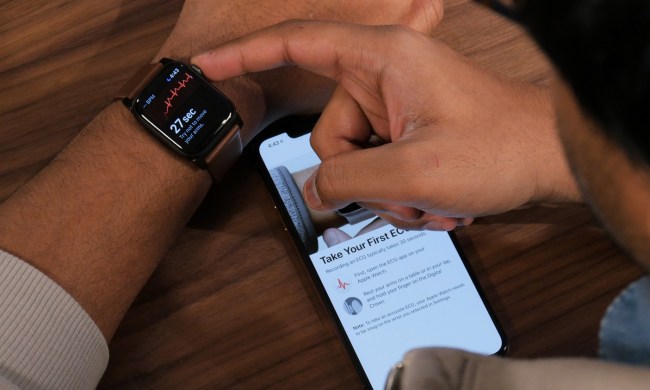Baruch “Boris” Goldstein, the co-founder and executive chairman of a company called Brain Scientific, Inc., is an aspiring tattooist. But don’t expect him to ink you a gnarly dragon or a tribal sleeve. Goldstein’s tattoos come with a few conditions: They’re on your head, they’re done using an ink made of all-around wonder material graphene, and they’re capable of reading your brainwaves. So you’ll need to go someplace else for that flaming skull or butterfly design you’ve been weighing up during lockdown.
To be clear, Brain Scientific’s new Brain E-Tattoo doesn’t resemble any piece of ink you’ve seen before. It’s a small patch, about the size of a postage stamp that looks, for all intents and purposes, like a microchip wafer affixed above the ear of the wearer. While the company uses the word “tattoo” to describe it, it’s more accurately referred to as a minimally invasive, implantable, 4-channel, micro electroencephalography (EEG) with graphene electrodes for continuous brain monitoring. And there’s a chance this bit of cyborg tech could one day help save your life.

“The idea is that we can print electrodes on your head in graphene ink,” Goldstein told Digital Trends. “Since graphene is only a single atom material — sometimes [in this case] it’s several layers, like two or three — it is more or less invisible. It’s thinner than a human hair.”
Once printed, this tattoo is intended to monitor brain wave activity on a constant basis, with minimal impact on a person’s daily life. The Brain E-Tattoo’s graphene-based electrodes are (or, when it’s ready for real-world usage, will be) connected to the aforementioned micro EEG that processes signals from its sensors, and wirelessly transmits this data to the cloud. Once there, Brain Scientific’s A.I. tools will perform continuous analysis, analyzing changes that take place in the brain to indicate everything from impending epileptic seizures to neurodegenerative diseases like Alzheimer’s.
Monitoring brain waves
Goldstein said that the company, whose main focus has historically been on A.I., didn’t intend to get into the hardware business. Instead, it was pushed there because it couldn’t find the right tools already available.
“Roughly five or six years ago, we said, ‘all right, screw it, we cannot find a small enough size,” he said. “’We can’t find something disposable. We’ll do it ourselves.’ So we did it. We are a data A.I. analysis company at our core. But unless we have a proper device to measure what we need, we cannot do data analysis.”
“Imagine that you have a copy of your brain or a copy of your muscle behavior a year ago, two years ago, five years ago — and you can then integrate that with A.I. databases to see what might be causing a change.”
Before building the Brain E-Tattoo, Brain Scientific created the NeuroCap, a disposable EEG headset boasting 22 electrodes and 19 active EEG channels. It resembles the headgear amateur wrestlers use to protect their ears and chin during matches. The pre-gelled, fixed electrode locations remove the time-munching task of having to measure a patient’s head and then manually place on EEG electrodes. Working with the company’s NeuroEEG amplifier device, Brain Scientific claims that it’s possible to initiate EEG studies in under five minutes, the same time it takes to prepare a bowl of instant noodles.
But sometimes that’s not quite fast enough. EEG studies are one thing, but to truly gather useful longitudinal brain data, you need a device that can comfortably be worn out on the street or in the home. Pre-gelled or not, no-one wants to wear an electrode-studded brain cap to the grocery store or on a first date at a romantic restaurant.
This is where the Brain E-Tattoo will enter the picture. It’s designed for long-term monitoring and uninterrupted brain data collection. It can do this because it’s small and, at least compared to a brain cap, invisible.
Smaller is better
The digital world, unlike the age of big, industrial engineering that preceded it, is all about making things smaller. Like the nanometer gap between transistors on a circuit board, small is good. Tininess is next to godliness. The late Mark Weiser, chief technologist at Xerox PARC, remarked upon this as far back as 1991 when he noted that the most profound technologies are the ones that disappear. “They weave themselves,” Weiser wrote, “into the fabric of everyday life until they are indistinguishable from it.”
While a microchip attached to a person’s head is certainly not invisible, it’s a lot less visible than the alternatives. It’s about as visible as… well, a tattoo.

And yet the use-cases are plentiful. While initially focused on predicting epilepsy, via electrical activity on the scalp, the Brain E-Tattoo is now expanding its goals to tracking other neurological conditions including Alzheimer’s disease, stroke, and Parkinson’s. (This expanded usage is evidenced by the fact that the product was previously called E-Epileptica, before its horizons broadened.) In each case, Goldstein believes that A.I. models can be used to tease out the characteristic patterns of brain activity.
The amount of data that can be extracted from a micro EEG is not what you might get from a full braincap, just like the resolution from an EEG is not the same as the information that could be gleaned using an fMRI or PET scan. But he thinks it will be sufficient — and the portability of the solution makes up for some of the lack of detail.
Goldstein also noted that EEG data does not have to exist in isolation, either. It can be combined with other biometrics, and other forms of data collection, to usefully give an idea of not just how the body is changing, but why.
“Imagine that you have a copy of your brain or a copy of your muscle behavior a year ago, two years ago, five years ago — and you can then integrate that with A.I. databases to see what might be causing a change,” he said. “Is it the water that you’re consuming? Is it the medication? Is it the food? Is it the climate? Overall, we believe that we can be part of the Big Data collected about humans. Integrated with the right data about food, water, medicine, and so on, maybe we will finally be able to show [why certain changes are] happening.”
What happens to this data would, of course, define whether we view such things as beneficial, dystopian, or, well, a little of column A and a little of column B. Earlier awareness of an impending seizure or a developing neurological issue could allow a person to take earlier proactive measures to mitigate the negative effects. That would be a positive (although also, potentially a source of anxiety).
An insurance company having access to that data could, for a healthy person, mean lower premiums. However, it might also mean the opposite — conceivably based on behavior that correlates with, or might otherwise prove predictive of, impending health issues. The implications of such technology are enormous.
A cyborg work in progress
We’re not there just yet, though. Brain Scientific currently has two FDA-cleared devices for brain monitoring, but its Brain E-Tattoo remains a work-in-progress. A press release announcing the technology is filled — as is the case with many similar announcements of forthcoming technologies — with the kind of cautious clarifications one can imagine a lawyer interjecting on behalf of an over-exuberant client: “Forward-looking statements, which involve assumptions and describe our future plans, strategies, and expectations, are generally identifiable by use of the words ‘may,’ ‘should,’ ‘would,’ ‘will,’ ‘could,’ ‘scheduled,’ ‘expect,’ ‘anticipate,’ ‘estimate,’ ‘believe,’ ‘intend,’ ‘seek’ or ‘project’ or the negative of these words or other variations on these words or comparable terminology.”

At present, the company is working on safety testing, proving its concept, and performance testing. Should all go according to plan, FDA submission will happen soon.
And then? There is undoubtedly something of the cyborg about the idea of a nigh-permanent graphene tattoo that gathers a constant stream of health data, tapped directly from your brain. But this is, in itself, not substantively different from the pacemaker that keeps a heart beating, the Apple Watch that measures your exercise and heart rate, the smartphone that structures much of how we perceive the world, and so on. These are all cyborgic technologies and we are, by dint of when we’re living, natural-born cyborgs.
The Brain E-Tattoo represents just one more step in that direction. As is the central conflict in all cyborg technology, hopefully, it’s one that ultimately augments humanity in a positive way. Maybe bookmark this page, and check back in a decade from now.


